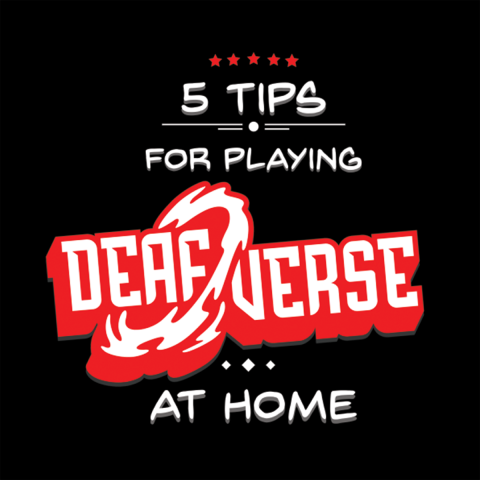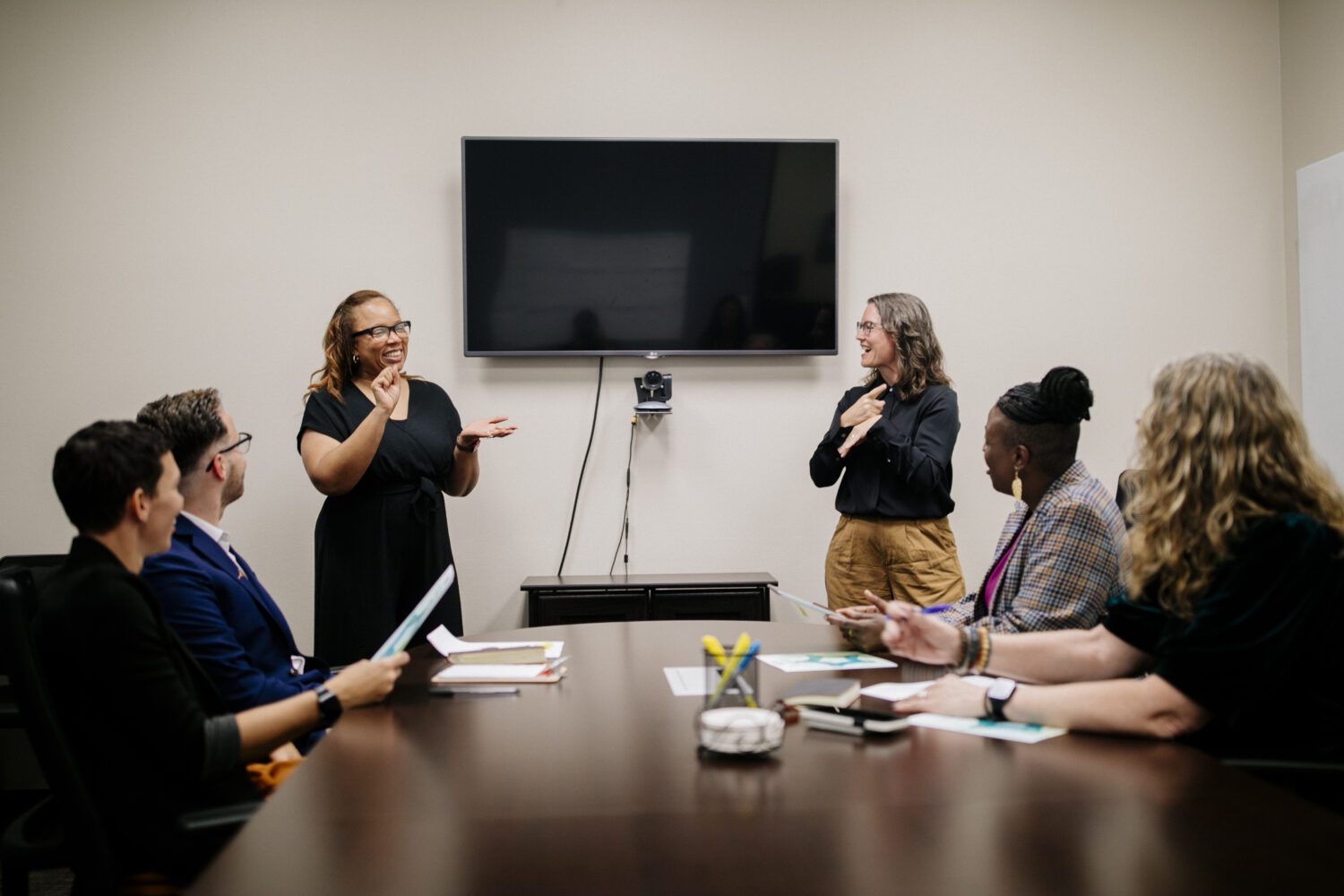For regularly updated information and resources in response to COVID-19, visit: nationaldeafcenter.org/covid19
[Disponible en español] [Download PDF]
Video description: https://tinyurl.com/s4m42uk
Online educational games are popular resources for many parents and teachers, especially as they struggle to teach students at home during the COVID-19 pandemic.
But for deaf middle and high school students, there are very few accessible online games or resources. That’s why Deafverse, the first-ever American Sign Language (ASL) accessible online game for deaf teenagers, is the go-to game for at-home learning.
Launched in 2019 by a team of deaf creators and educators at the National Deaf Center on Postsecondary Outcomes, Deafverse is a free, choose-your-own-adventure game that is equally focused on skill-building and fun. It is specifically designed for deaf players to experience first-person gameplay through different worlds.
Deafverse World One: Duel of the Bots begins with the player having just escaped from retrieving a magical, sacred comic book called the Deafverse. They meet game narrator Justin, get a sidekick named Catbot, and are tasked with making decisions both playful — like stopping a rogue ‘bot from wreaking havoc — and ones that deaf teenagers face in reality, like what to do when an ASL interpreter in a classroom isn’t helpful, a movie theater doesn’t have captioning, or a store clerk doesn’t know ASL.
Ready to play? Here are five tips to make the most of Deafverse for deaf students learning at home.
Tip #1: Deafverse is for everyone
For deaf teens, Deafverse World One is an opportunity to practice self-determination — the process by which people make their own choices and decisions — and build self-advocacy skills by allowing them to make mistakes in a safe environment. Research shows these skills and self-beliefs are essential for success during and after high school.
Self-advocacy becomes paramount during a time of crisis like a pandemic, because deaf teens may need to advocate for themselves in the midst of disruptions to the school system and the transition to online learning.
For families and teachers, Deafverse can give everyone some breathing room from traditional at-home learning tools. It can also be a low-stakes way to lean into online learning. Parents and educators can use the downloadable Teacher Strategy Guide to support game play, with bonus discussion questions and activities.
For others, Deafverse is a unique way to see ASL storytelling in action and get an idea of what it means to be deaf in today’s world. For example, ASL students can build their language skills by seeing the ASL narrative along with English text, while also learning how to be a stronger ally for deaf communities.
Tip #2: Get a boost from your backpack
Debuted in February, the new backpack feature in Deafverse is there to help players collect badges, photos, and comic pages throughout their online adventure.
Each badge — such as Natural Leader, Robot Detective, and Deafverse Explorer — unlocks additional resources and new videos of deaf people sharing real life stories about their experiences in school, community, and work.
These videos encourage deaf teens to think about strategies they can use in their own lives to advocate for themselves. The backpack also tracks game progress and can be shared with teachers, parents, and other players to show how players are succeeding at the game (and its motto, “Choose Your Future”).
Tip #3: Try out new strategies
Deafverse has downloadable Player and Teacher Strategy Guides, for extra resources that can be printed out and used at home.
The Player Strategy Guide is an interactive workbook that uses fun prompts and activities to apply what players have learned in the game to their own lives.
Teachers and parents can use the Teacher Strategy Guide to discuss game scenarios, expand on the game experience, and connect in new ways with deaf students and children. They can also look forward to the debut of Deafverse World Two, which will focus on navigating the workplace.
Tip #4: Connect with others
Playing games is more fun when the experience is shared with others. More than 6,000 teens have played Deafverse, and countless educators have incorporated it into their classrooms and learning plans.
Follow Deafverse on Facebook and Instagram and connect with other players by using the hashtag #Deafverse. And be sure to tap into the Deafverse GIPHY library to send fun Deafverse GIFs to fellow players, motivate a teen to play the game, or make your point in ASL in a text or post.
Tip #5: Take it easy
As beneficial as online educational games are, screen breaks are necessary — especially during “shelter in place” or quarantine orders. For offline fun, download and print new Deafverse coloring pages, go outside and enjoy nature, read a book, check in on friends or loved ones, or just veg out.
About Deafverse
Using evidence-based research and game-based learning strategies, Deafverse is designed for deaf teenagers to build confidence, learn their rights, and develop skills to succeed in their transition from high school to adult life.
It is a time of great uncertainty for all teens, yet unlike their hearing peers, deaf teens also have to know how to request the accommodations they need and the access they are required to have by law. It is especially critical considering recent National Deaf Center research which shows that deaf Americans lag in employment, education, and undergraduate college achievement.
Deafverse includes:
- A free game with log-in at deafverse.com or at NationalDeafCenter.org/game
- ASL and English versions that can be played at school, home, and in transition programs or vocational rehabilitation settings.
- Downloadable Player Strategy Guide for fun and further exploration of real-world scenarios and feelings.
- Downloadable Teacher Strategy Guide with learning objectives, a summary of the story and characters, important vocabulary, activity guides for each chapter, and other supplemental materials.
- “Meet the Team” profiles of the deaf creators of Deafverse.
- Email subscription for news, updates, and tips.
- GIFs to share and connect with the Deafverse community.
In addition to Deafverse, the National Deaf Center provides families and professionals a full array of resources for transition planning designed to help teenagers successfully prepare for and succeed at life after high school. It also provides one-on-one help to families, schools, and organizations that need customized assistance or referrals.









